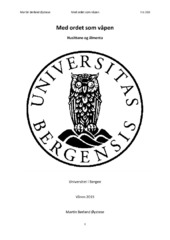| dc.description.abstract | The Hussite movement occurred in a volatile period. After ending the papal schism in the Catholic Church, the Conciliar Movement searched for ways to again unify all of Christendom under the Church Council. They started by burning the heretic priest Jan Hus in 1415. In the years prior to this Hus had preached against a Church characterized by greed and worldly power. From the chapel Bethlehem in Prague he encouraged his followers to discern between what the authorities told them and what they could read for themselves in the Bible. After Hus' death, his followers would revolt against the Church. Within a few years they had founded several Hussite centres. The two most important were to be found in Prague and Tábor. Prague was a divided city with both moderate and radical Hussites, and a group of Catholics. The Hussites in Prague tried to find diplomatic solutions with the Catholic Church. Tábor on the other hand were radical, and wanted to create a society based on the model of the first Christians. It would be a place where everyone owned everything together. At the heart of the conflict where the opposing views on what should go on in public. The Church saw itself as representing God. Its duty was to tell the public what to mean and do. The duty of the public was to receive and obey. The Hussite movement said that Christ, not the pope was the head of the Church, and that everybody who read could find truthfor themselves in the Bible. This view would change the public into a realm for debate and validating of arguments. These views were irreconcilable, and the Catholic crusades against the Hussite were inevitable In 1420, the Catholic Church sent the first of five crusades against the heretics in Bohemia. In order to stand united against this mighty foe, the different Hussite groups tried to find common ground. The answer to this was the four articles: 1. Everyone should have the right to preach the word of God 2. All Christians should be entitled to receive both the bread and the wine of the communion 3. Priests should not be allowed to hold secular office 4. Everyone should be punished equally for their sins The four articles broadened the public sphere in Bohemia, and the Hussites would strengthen the people's right to participate in public throughout the crusade period (1420-1433). They would allow women to preach and allowed criticism to surface. The best example is Petr Chelčický. Despite his simple upbringing and vocation as a farmer, he would ,with no formal education, establish himself as a respected and wise critic. He criticised both Catholics and Hussites, as well as established Church doctrines. This made him the clearest example of how the Hussite public sphere could function. Even though the Hussites won the military battles against the Papal church, they ended up with only keeping the chalice of the communion after reuniting with the papal Church in 1433. Still, Hussite thought would survive, and be present in Bohmemia until the Catholic church drove out everyone that was not Catholic in the 1620's. | en_US |
